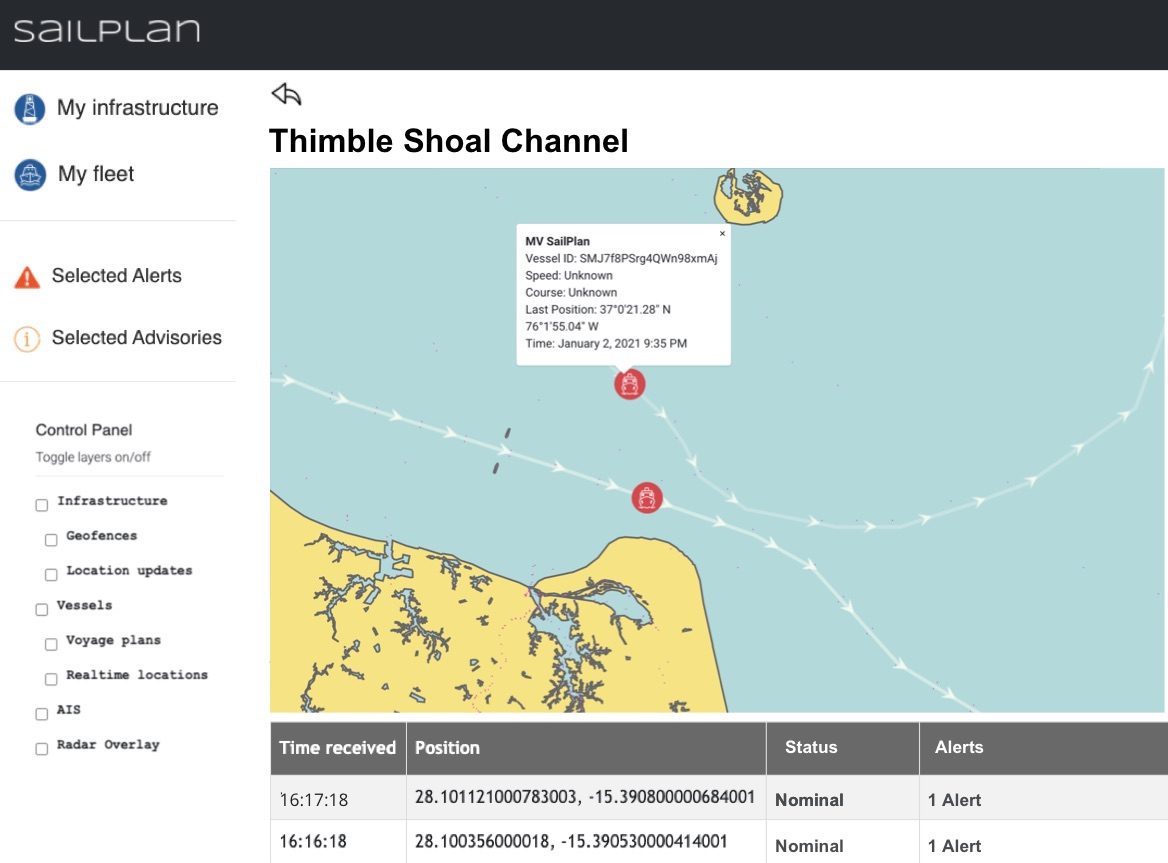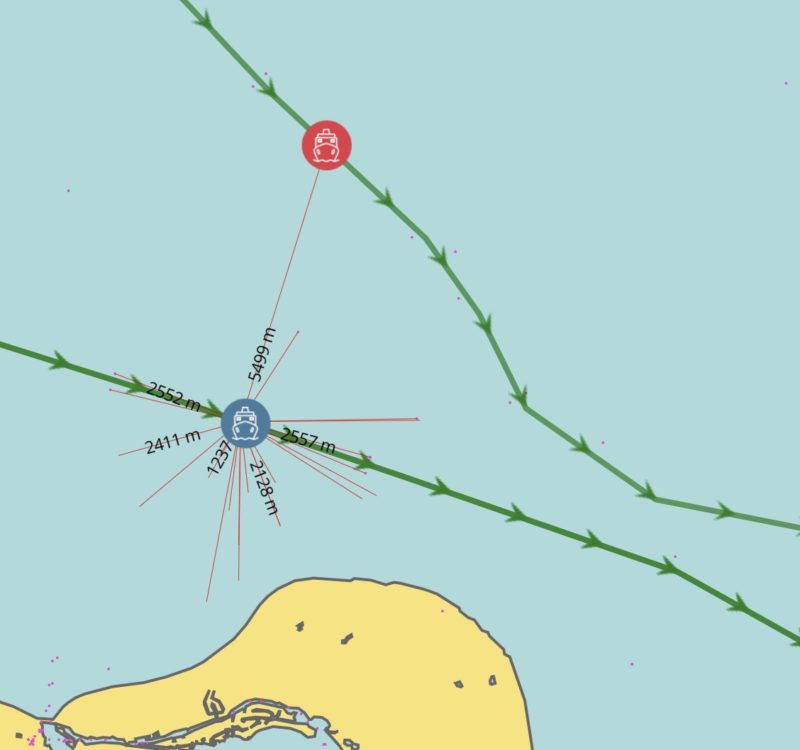Oil Supertankers Headed For China Jump To The Highest In A Year
By Bill Lehane (Bloomberg) –Supertankers hauling crude oil to China surged to the highest in almost a year. Some 124 of the vessels are signaling China — the world’s biggest oil...


A screengrab of the SailPlan platform's user interface. Image courtesy SailPlan
Jacob Ruytenbeek is Founder and CEO of SailPlan, a newly launched intelligent navigation platform for ships that promises to make seafaring safer and ship operations more efficient. We had a chance to ask Jacob a few questions about the platform and his plans for the future. Here’s what he had to say:
Can you provide an overview of SailPlan and how it works?
SailPlan is an intelligent navigation platform for ships that makes navigation dramatically safer and more efficient. Almost 1,000 ships have been lost over the past ten years, resulting in thousands of lives lost. Most catastrophic incidents result from human error, as navigators rely primarily on their eyes and ears in crowded environments with little room for error.


SailPlan improves navigation in three key ways: through improved context, awareness, and understanding of intent. We combine real-time data with predictive analytics to inform the navigator and shoreside operations of what’s happening now and what will happen in the future, allowing for safer, more efficient ship operations.
Today’s Electronic Navigational Charts are little more than vector versions of their raster predecessors. They’re not good at displaying dynamic information, yet the sea is a dynamic place. SailPlan provides an advanced, data-driven chart that is both human and machine-readable. Our charts make it easier for the navigator to interpret the chart, understand where the ship is, where it can safely travel, and what rules apply at each point along its voyage. The ship operator can also incorporate external mapping data or custom rulesets, such as areas-to-avoid and preferred routes specific to the ship.
SailPlan also improves the situational awareness picture of what’s happening around it. Existing collision avoidance tools such as AIS, Radar, and ARPA, require manual input by the navigator and are noisy. It is difficult for the navigator to determine which vessels and obstacles pose the most significant risk, especially in congested areas. These tools also assume straight-line motion, even when straight-line motion is implausible, such as around bends or in crowded port environments.
SailPlan makes sense of all this noise. It determines which vessels and obstacles pose the greatest risk and highlights those vessels to the navigator, reducing workload and simplifying collision and obstacle avoidance. Through an Application Programming Interface (API), SailPlan can be expanded to incorporate a wide variety of external sensors such as cameras, thermal imaging, acoustic sensors, or navigational sonar.


SailPlan’s awareness extends beyond the vessel’s present situation and into the future. SailPlan combines real-time situational awareness data with predictive analytics to create a view of the future. SailPlan analyzes predicted weather, port congestion, vessel traffic, and the condition of the ship’s onboard systems to generate an unparalleled understanding of the future.
Through our predictive algorithms, SailPlan analyzes the expected future positions of vessels and proactively alerts the navigator of potential conflicts well before a collision scenario can materialize – far in advance of what AIS or radar can do. It does this with minimal input from the navigator. The result is a much safer and more efficient voyage.


SailPlan is not limited to the bridge either. SailPlan can monitor the engine and other systems’ health as well. It makes the information gathered available in real-time to shoreside personnel through the SailPlan Dashboard. Shoreside personnel must no longer wait for an update from the crew since they can access a ship’s digital twin in real-time. Through the SailPlan Dashboard, shoreside personnel can view a digital twin of their entire fleet and be alerted to both trend and point-in-time problems, allowing them to respond faster to emergencies and maintenance issues more quickly.
For instance, shoreside personnel can be proactively alerted to a vessel developing a list, experiencing excessive roll, or where an engine has failed. Likewise, SailPlan can alert shoreside operations to changes in a ship’s voyage plan, deviations from its plan, or breaches of business rules. And since the dashboard is delivered via the cloud, it’s accessible everywhere, whether from an emergency operations center or a mobile phone.
It’s a giant leap forward for ship operators looking to improve operating efficiency and the ship’s safety and crew.
Tell us a little bit about your own background and what prompted you to launch SailPlan?
I grew up in South Florida with a passion for being on the water. I’ve spent my career around emerging aerospace and defense technologies – most recently leading the commercialization of technologies that provide for safe, scalable aerial-drone traffic. I realized that maritime transportation was evolving in a silo and that solutions from the aviation industry could be adapted to the maritime industry to increase safety and efficiency. These technologies could have mitigated so many maritime disasters.
Costa Concordia resonated with me, as did El Faro. How does a modern ship mistakenly sail into a category four hurricane? A complete real-time situational awareness picture, available both onboard and shoreside, might have mitigated these disasters and saved lives. We have so much data available today, yet we still communicate via voice – leading to delay and miscommunication. That’s why we provide a holistic view of the ship on a single, integrated platform, both shoreside and onboard – so we can avoid or mitigate disasters like these in the future. The need for better data became the guiding light for SailPlan and our mission of zero. Zero lives lost. Zero ships lost.
How would your average ship navigator interact with the SailPlan platform?
As a platform, SailPlan can be configured in many ways with various use cases. A typical use-case employs SailPlan as an intelligent assistant on a bridge display or tablet. The navigator inputs a destination or a set of waypoints into SailPlan’s platform while planning a voyage. SailPlan proactively identifies collision risks, adverse weather conditions, bottlenecks along the route, and recommends adjustments to the plan to optimize the voyage. SailPlan does this while incorporating custom business logic and constraints into the recommendations.
A navigator must make sense of the wealth of data available to them. SailPlan sits alongside ECDIS on the bridge and gives the navigator a much broader, clearer view of their voyage with an interface that’s simple to understand. ECDIS displays targets within a limited range and requires a navigator to interpret the data coming out of it. SailPlan shows targets along the entirety of the voyage plan and makes sense of the data for the navigator, automatically. If the vessel is planning to voyage too close to a hazard, we can alert that proactively to the navigator and can automatically recommend safe passage around it. We also can escalate those shoreside for additional oversight.
During the voyage, SailPlan also monitors conformance to plan – how well the ship follows its stated plan in both space and time. It tracks this performance to plan and proactively alerts the navigator to deviations and possible alternatives that can save time, fuel, or route around adverse weather. Sailplan also recommends plan changes as new data becomes available. For example, suppose port congestion indicates extended anchorage outside a port or adverse weather conditions are forecast along the route. SailPlan can recommend speed, course, or other changes to maintain schedule or reduce fuel consumption in these cases. Through our predictive analytics, SailPlan can recommend these plan changes days in advance of the scenarios developing, giving navigators more time to take the appropriate action to maximize safety, maintain schedule, and reduce operational expenses.
Can you provide an update on the company and where do you plan to be 1, 3, or 5 years from now?
SailPlan is ushering in one of the most significant changes to navigation since people first set sail thousands of years ago: the shift away from sight and hearing as the primary means of navigation. The ability to avoid a collision situation while ships are still hundreds of miles apart is a shift away from reactive navigation through eyes and ears to proactive navigation through digital awareness.
When I speak with ship owners, they immediately recognize the impact that SailPlan will have on their operations. And our unique value-sharing model allows ship owners to get the benefits of SailPlan with minimal investment while realizing dramatic cost savings across their fleet.
Thanks for speaking with us, Jacob!
More information can be found on the SailPlan website here.
Join the gCaptain Club for curated content, insider opinions, and vibrant community discussions.


Join the 105,942 members that receive our newsletter.
Have a news tip? Let us know.
Access exclusive insights, engage in vibrant discussions, and gain perspectives from our CEO.
Sign Up




Maritime and offshore news trusted by our 105,942 members delivered daily straight to your inbox.



Essential news coupled with the finest maritime content sourced from across the globe.
Sign Up